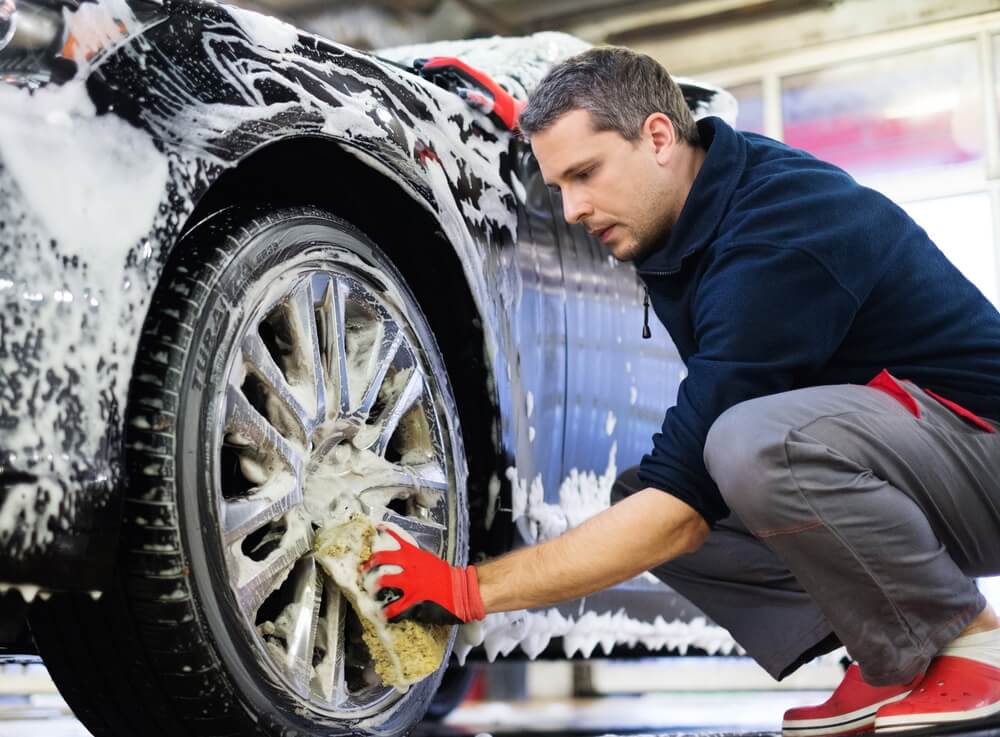After applying a ceramic coating to your car, it’s essential to follow the correct washing procedure to maintain its effectiveness and longevity. Here’s a step-by-step guide on how to wash your car after ceramic coating application:
Wait for the curing period: Most ceramic coatings require a curing period before they fully bond to the paint surface. The curing time can vary depending on the specific product you used, so refer to the manufacturer’s instructions. It typically ranges from 24 to 72 hours.
Gather the necessary supplies: For washing your car, you’ll need the following supplies:
Two buckets: One for soapy water and the other for rinsing.
Car wash shampoo: Choose a pH-neutral shampoo specifically designed for automotive use.
Microfiber wash mitts or soft sponges: Avoid using harsh brushes or scrubbers that can potentially damage the coating.
Microfiber towels or drying towels: These are gentle on the coating and won’t introduce scratches.
Grit guards (optional): Placed at the bottom of the wash bucket to trap dirt and prevent it from being reintroduced to the wash mitt.
Pre-rinse the vehicle: Start by rinsing your car thoroughly with a hose to remove loose dirt, debris, and contaminants. This step helps prevent any potential scratching during the washing process.
Prepare the soapy water: Fill one of the buckets with clean water and add the recommended amount of car wash shampoo. Follow the instructions on the bottle for the appropriate dilution ratio.
Wash one section at a time: Dip the wash mitt or sponge into the soapy water and start washing one section of the car at a time. Use gentle, straight motions to avoid creating swirl marks. Rinse the mitt or sponge frequently in the rinse bucket to remove dirt and prevent reintroducing it to the paint surface.
Rinse thoroughly: After washing each section, rinse it thoroughly with clean water to remove any remaining soap residue.
Dry gently: To avoid scratching the ceramic coating, use a soft microfiber towel or drying towel to dry the vehicle. Pat the surface gently rather than rubbing vigorously.
Inspect and touch-up if necessary: After drying, inspect the car’s surface for any missed spots, smudges, or water spots. If needed, you can use a quick detailer or spray sealant recommended by the ceramic coating manufacturer to touch up the areas.
Also read – Paint Protection Film
What Are The Different Types Of Matte Finish?
Matte finishes are characterized by their low or non-reflective surface, which lacks gloss or shine. There are several types of matte finishes commonly used in various industries. Here are some of the different types:
- Standard Matte: This is the most common type of matte finish, characterized by a smooth, non-reflective surface with a subtle texture. It provides a soft, velvety appearance.
- Satin Matte: Satin matte finishes have a slightly higher sheen than standard matte finishes. They offer a delicate balance between a matte and a glossy appearance, providing a smooth and elegant look.
- Ultra Matte: Also known as “dead matte” or “flat matte,” this finish has the lowest level of sheen and is highly non-reflective. It has a powdery appearance and gives a completely matte, almost chalk-like effect.
- Textured Matte: Textured matte finishes feature additional tactile qualities, such as a fine grain or rough surface. These finishes can add depth and interest to surfaces, giving them a unique and visually appealing appearance.
- Metallic Matte: Metallic matte finishes combine a matte appearance with metallic elements. They have a subdued, low-gloss finish with a metallic sheen, creating a contemporary and sophisticated look.
- Ceramic Matte: This type of matte finish is commonly used in ceramics and pottery. It provides a soft, matte surface with a slight grainy texture, enhancing the tactile experience.
- Velvet Matte: Velvet matte finishes offer a luxurious and plush appearance. They have a soft, velvety texture and a low sheen, resembling the feel of velvet fabric.
Understanding Matte Finishes: Myths and Facts
Matte finishes have gained popularity for their unique aesthetic appeal, but they are also surrounded by several myths and misconceptions. Let’s explore some common myths and facts to gain a better understanding of matte finishes:
Myth 1: Matte finishes are prone to scratches. Fact: While it is true that matte finishes can show scratches more readily than glossy finishes, it doesn’t mean they are inherently fragile. The susceptibility to scratches depends on the material and the specific manufacturing process. Some matte finishes are designed to be more resistant to scratches, and proper care and maintenance can minimize the appearance of scratches.
Myth 2: Matte finishes require high maintenance. Fact: Matte finishes are often perceived as high-maintenance because they can show fingerprints, smudges, and stains more easily than glossy finishes. However, this doesn’t mean they are significantly more difficult to maintain. Regular cleaning with appropriate methods and materials, such as microfiber cloths and mild cleansers, can effectively remove dirt and maintain the matte appearance.
Myth 3: Matte finishes are difficult to clean. Fact: Cleaning matte finishes may require a slightly different approach compared to glossy finishes, but it is not necessarily difficult. Using the right cleaning techniques and products specifically designed for matte surfaces can effectively remove dirt and stains. Avoid using abrasive cleaners or rough scrubbing tools that could damage the finish.
Myth 4: Matte finishes are only available in limited colors. Fact: Matte finishes are available in a wide range of colors and shades, just like glossy finishes. The choice of colors may vary depending on the material and the specific product or industry. Matte finishes can offer a sophisticated and contemporary look in various colors, including neutrals, pastels, bold hues, and even metallic shades.
Myth 5: Matte finishes are only suitable for specific applications. Fact: Matte finishes can be used in a variety of applications, including furniture, automotive, electronics, appliances, and interior design. They can provide a sleek, modern, or even vintage appearance, depending on the context and desired style. Matte finishes are versatile and can be applied to different materials, such as metal, wood, plastic, and ceramics.
It’s important to note that the characteristics and properties of matte finishes can vary depending on the specific product and manufacturer. Always refer to the manufacturer’s guidelines for cleaning and maintenance instructions to ensure the longevity and beauty of matte-finished surfaces.



